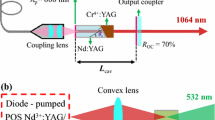Abstract
The record picosecond power density recently achieved with a current-pumped laser diode turned our attention to a still unexplained 50-year-old phenomenon termed “internal Q-switching”. The correlation found experimentally here between the relatively high breakdown voltage (∼5–11 V) in a heavily doped single-heterostructure laser diode and its high-power picosecond lasing provides a means for solving the puzzle. Together with the experimental fact that picosecond lasing occurs from the p-n junction, this implies that internal Q-switching is determined by the compensated layer rather than by “traditional” single-heterostructure waveguide. This finding is valid for various growth technologies independently of whether the high break-down voltage and picosecond lasing are achieved by exact compensation of shallow donors by shallow acceptors, or by doping profile gradients.
Similar content being viewed by others
References
A. Kilpelä, R. Pennala, and J. Kostamovaara, Rev. Sci. Instrum. 72, 2197 (2001).
J. E. Ripper and J. A. Rossi, IEEE J. Quant. Electron. 10, 435 (1974).
S. N. Vainshtein and J. T. Kostamovaara, J. Appl. Phys. 84, 1843 (1998).
S. N. Vainshtein, V. Rossin, A. Kilpelä, J. Kostamovaara, R. Myllylä, and K. Määttä, IEEE J. Quant. Electron. 31, 1015 (1995).
F. D. Nunes, N. B. Patel, and J. E. Ripper, IEEE J. Quantum Electron. 13, 675 (1977).
S. N. Vainshtein and J. T. Kostamovaara, Proc. SPIE 4354, 45 (2000).
S. Vainshtein, J. Kostamovaara, V. Lantratov, N. Kaluzhnyy, and S. Mintairov, Proc. SPIE 6593, 65930B (2007).
B. Lanz, S. Vainshtein, J. Kostamovaara, V. Lantratov, and N. Kaluzhnyy, Proc. SPIE 7631, 763113 (2009).
F. R. Nash, J. Appl. Phys. 44, 4696 (1973).
H. C. Casey, D. D. Sell, and K. W. Wecht, J. Appl. Phys. 46, 50 (1975).
Author information
Authors and Affiliations
Corresponding author
Additional information
The article is published in the original.
Rights and permissions
About this article
Cite this article
Lanz, B., Vainshtein, S.N., Lantratov, V.M. et al. Picosecond internal Q-switching mode correlates with laser diode breakdown voltage. Semiconductors 47, 406–408 (2013). https://doi.org/10.1134/S1063782613030159
Received:
Accepted:
Published:
Issue Date:
DOI: https://doi.org/10.1134/S1063782613030159




